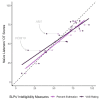The Reliability and Validity of Speech-Language Pathologists' Estimations of Intelligibility in Dysarthria
- PMID: 36009074
- PMCID: PMC9406197
- DOI: 10.3390/brainsci12081011
The Reliability and Validity of Speech-Language Pathologists' Estimations of Intelligibility in Dysarthria
Abstract
This study examined the reliability and validity of speech-language pathologists' (SLP) estimations of speech intelligibility in dysarthria, including a visual analog scale (VAS) method and a percent estimation method commonly used in clinical settings. Speech samples from 20 speakers with dysarthria of varying etiologies were used to collect orthographic transcriptions from naïve listeners n=70 and VAS ratings and percent estimations of intelligibility from SLPs n=21. Intra- and interrater reliability for the two SLP intelligibility measures were evaluated, and the relationship between these measures was assessed. Finally, linear regression was used to evaluate the relationship between the naïve listeners' orthographic transcription scores and the two SLP intelligibility measures. The results indicated that the intrarater reliability for both SLP intelligibility measures was strong, and the interrater reliability between the SLP ratings was moderate to excellent. A moderate positive relationship between SLPs' VAS ratings and percent estimations was also observed. Finally, both SLPs' percent estimations and VAS ratings were predictive of naïve listeners' orthographic transcription scores, with SLPs' percent estimations being the strongest predictor. In conclusion, the average SLP percent estimations and VAS ratings are valid and reliable intelligibility measures. However, the validity and reliability of these measures vary between SLPs.
Keywords: dysarthria; speech intelligibility; speech-language pathologists.
Conflict of interest statement
The authors declare no conflict of interest.
Figures




Similar articles
-
Can We Trust Our Ears? How Accurate and Reliable Are Speech-Language Pathologists' Estimates of Children's Speech Intelligibility?Am J Speech Lang Pathol. 2025 Mar 10;34(2):853-867. doi: 10.1044/2024_AJSLP-24-00247. Epub 2025 Feb 24. Am J Speech Lang Pathol. 2025. PMID: 39993151 Free PMC article.
-
Agreements between speech language pathologists and naïve listeners' judgements of intelligibility in children with cleft palate.Clin Linguist Phon. 2022 Nov 2;36(11):1010-1028. doi: 10.1080/02699206.2021.1983021. Epub 2021 Oct 1. Clin Linguist Phon. 2022. PMID: 34597196
-
Reliability of Perceptual Judgments of Phonetic Accuracy and Hypernasality Among Speech-Language Pathologists for Children With Dysarthria.Am J Speech Lang Pathol. 2021 Jun 18;30(3S):1558-1571. doi: 10.1044/2020_AJSLP-20-00144. Epub 2021 Mar 1. Am J Speech Lang Pathol. 2021. PMID: 33647216 Free PMC article.
-
"You Say Severe, I Say Mild": Toward an Empirical Classification of Dysarthria Severity.J Speech Lang Hear Res. 2021 Dec 13;64(12):4718-4735. doi: 10.1044/2021_JSLHR-21-00197. Epub 2021 Nov 11. J Speech Lang Hear Res. 2021. PMID: 34762814 Free PMC article.
-
The Relationship Between Voice Parameters and Speech Intelligibility: A Scoping Review.J Voice. 2024 May 15:S0892-1997(24)00130-9. doi: 10.1016/j.jvoice.2024.04.013. Online ahead of print. J Voice. 2024. PMID: 38755076 Review.
Cited by
-
Efficacy and feasibility of a digital speech therapy for post-stroke dysarthria: protocol for a randomized controlled trial.Front Neurol. 2024 Jan 31;15:1305297. doi: 10.3389/fneur.2024.1305297. eCollection 2024. Front Neurol. 2024. PMID: 38356882 Free PMC article.
-
Acoustic and Kinematic Predictors of Intelligibility and Articulatory Precision in Parkinson's Disease.J Speech Lang Hear Res. 2024 Oct 8;67(10):3595-3611. doi: 10.1044/2024_JSLHR-24-00153. Epub 2024 Sep 11. J Speech Lang Hear Res. 2024. PMID: 39259883 Free PMC article.
-
How to Efficiently Measure the Intelligibility of People With Parkinson's Disease.Am J Speech Lang Pathol. 2025 Jan 7;34(1):70-84. doi: 10.1044/2024_AJSLP-24-00080. Epub 2024 Oct 30. Am J Speech Lang Pathol. 2025. PMID: 39475678 Free PMC article.
-
Does Native Language Matter in Perceptual Ratings of Dysarthria?J Speech Lang Hear Res. 2024 Sep 12;67(9):2842-2855. doi: 10.1044/2024_JSLHR-23-00668. Epub 2024 Apr 25. J Speech Lang Hear Res. 2024. PMID: 38662924 Free PMC article.
-
Can We Trust Our Ears? How Accurate and Reliable Are Speech-Language Pathologists' Estimates of Children's Speech Intelligibility?Am J Speech Lang Pathol. 2025 Mar 10;34(2):853-867. doi: 10.1044/2024_AJSLP-24-00247. Epub 2025 Feb 24. Am J Speech Lang Pathol. 2025. PMID: 39993151 Free PMC article.
References
-
- Yorkston K.M., Dowden P.A., Beukelman D.R. Intelligibility measurement as a tool in the clinical management of dysarthric speakers. In: Kent R.D., editor. Intelligibility in Speech Disorders: Theory, Measurement, and Management. John Benjamins Publishing; Amsterdam, The Netherlands: 1992. pp. 265–285.
-
- American Speech-Language-Hearing Association Dysarthria in Adults. [(accessed on 29 June 2022)]. Available online: https://www.asha.org/practice-portal/clinical-topics/dysarthria-in-adult....
Grants and funding
LinkOut - more resources
Full Text Sources

